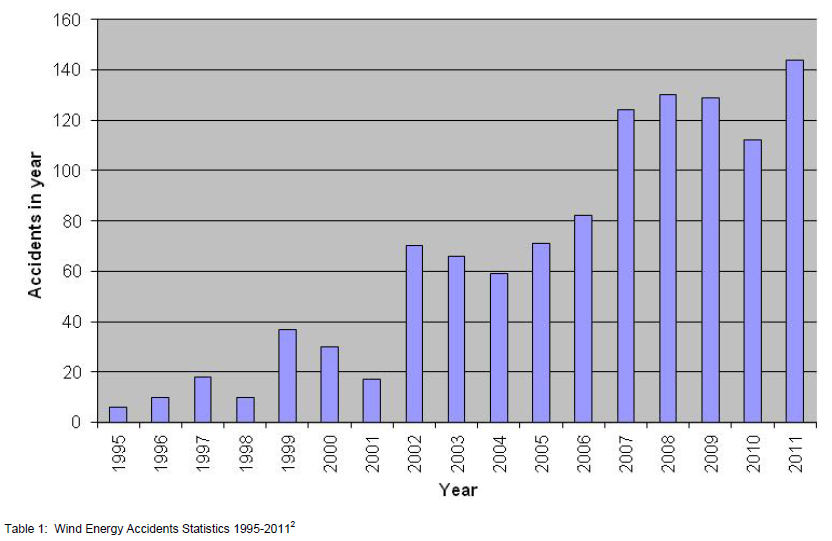In the emerging renewable energy sector, developing any health and safety systems and guidelines that offer a ‘minimal’ standard of health and safety information for workers seems to be slow to evolve. The UK, and in particular the Wind Energy sector, has seen fatalities and other major incident events occur, therefore the spotlight and rightly so, is on Health & Safety. However, its reluctance or perhaps speed of action is what restricts the sector in addressing the benefits the introduction of health and safety information in the form of a ‘Safety Passport’ would deliver. We as a company have identified this and urge the sector to review their need and potentially align to other high risk sectors like construction, which embraces the idea.
 |
| [relatedPosts title=”Related Posts”] |
|
|
It is estimated that wind energy capacity will be over 8.5GW (overtaking nuclear) by the end of 2013, increasing to 6GW offshore alone by 2015. The industry itself will boom with the increasing need for competent professionals from the feasibility stages, through the construction phase, followed by the operational and maintenance phases. Many of the work-force will be from other industries, generally skilled or knowledgeable and have some form of health and safety awareness or training. These ‘other’ industries, in contrast, are ‘safety’ reliant whereas the wind energy sector holds pockets of safety related training (typically offshore requirements), but no holistic coverage. Lord Browne pointed out in March 20111 the government supported the oil and gas supply chain in its early days, with the result that it now generates £16bn a year and employs more than 300,000 people in the UK. So the question remains, given the sector emergence and a desire not to undergo a permissioning regime, does the sector need to look at an ‘Accredited Safety Passport Scheme’ similar to those used in other industries/sectors?
We have large installations, both onshore and offshore, whilst we are seeing an increase in medium and small sized turbine installations throughout the UK. Many of these installations will require management under ‘Construction, Design & Management Regulations’, however, safety doesn’t stop at ‘Construction’. Furthermore, there are a large number of micro-wind turbines in the UK, either free standing or on buildings, these too require forms of ‘grid’ or ‘battery unit’ connection and safety needs to be considered with these developments in mind also. At whatever size we look within the wind energy sector, the hazards in the industry include working from height, slips and trips, contact with moving machinery, possible risks of electrocution or from fire and construction in windy conditions, all significant and constant, whatever the size of installation. Offshore construction is even more hazardous including risks from large waves, diving activities, siting the turbines and issues such as stepping from a boat onto a turbine.
As previously stated, wind turbines require maintenance; therefore workers will be exposed to these risks on a consistent basis, but how do you control the risks and show competence and overall appreciation? Many industries utilise a safety passport, so why can’t the entire ‘Renewable Energy’ Sector do the same. The principles behind the passport are to help workers gain minimum levels of health and safety knowledge, whilst also ensuring that they are aware of their environmental responsibilities before being allowed access to a workplace e.g. wind farm or turbine. Workers receive passports by attending appropriately accredited training courses, designed to raise awareness of the associated hazards/risk within the given working environment.
The accident statistical trend is as expected – as more turbines are built, increasing. The figures of recorded accidents mirror this, with average figures increasing significantly since 1992.
This general trend upward in accident numbers is predicted to continue to escalate unless we step in with a solution.
What we would like to see is a universal consensus of opinion in what should be included in a recognised safety passport for the ‘Renewable Energy Sector’ and specifically for the ‘Wind Energy’ element of it. Therefore, I would like to invite stakeholders to a meeting, the first I believe, in the UK to determine the best way forward.
If you or your primary stakeholders are interested in convening a meeting we ask that you contact us at [email protected] so we can arrange a suitable location and starting point in what is bound to be an eventful journey in delivering safety to the sector, ensuring that we put ‘people first’ and strive toward zero accidents.
Warren Fothergill CMIOSH
Health & Safety Manager
Group Safety Services
01472 889229
.






